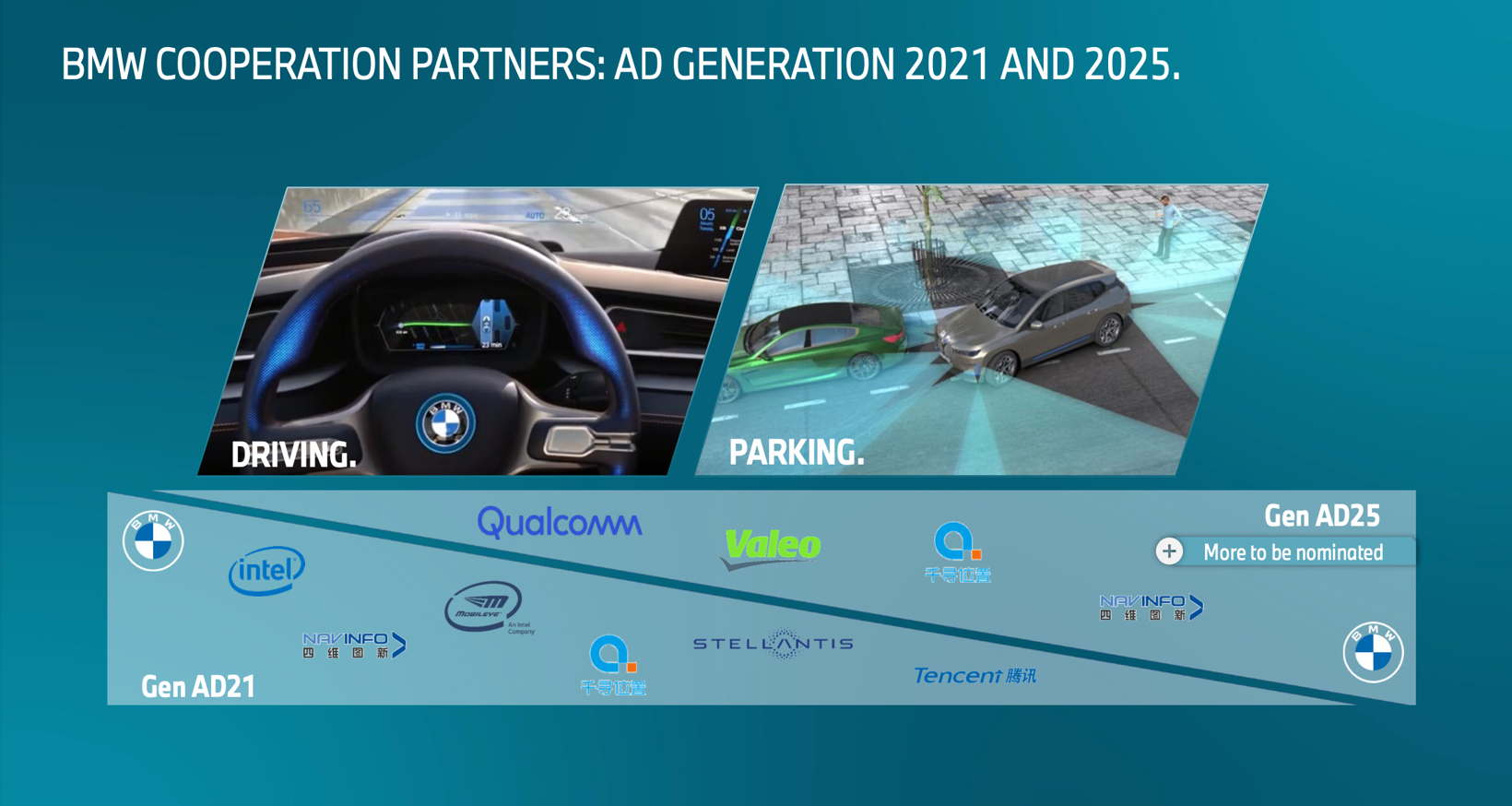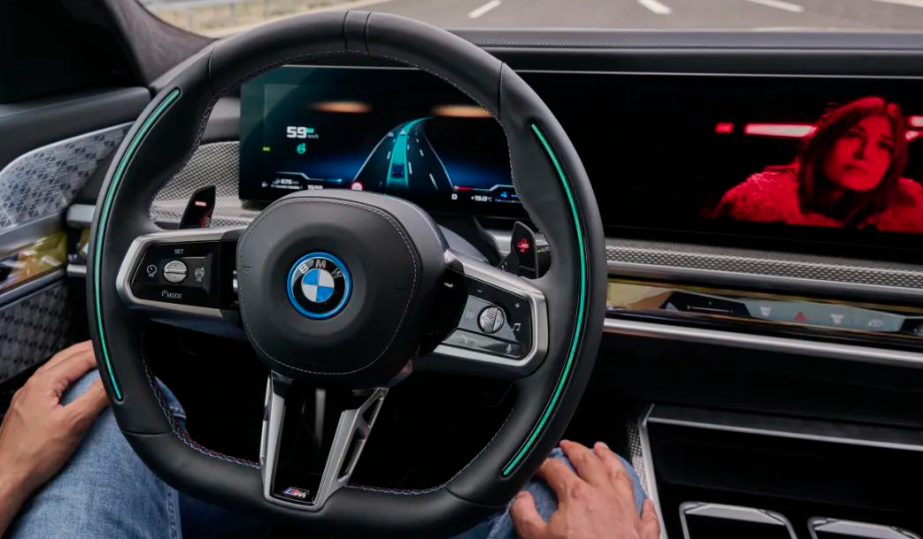On December 14, BMW Group’s vehicles equipped with L3 level autonomous driving function officially obtained the license for high-speed autonomous driving testing on highways in Shanghai. BMW is fully prepared for the adaptation and application of L3 level autonomous driving function in China, meeting the requirements of China’s complex traffic conditions and driving characteristics of Chinese customers. The company will closely follow the requirements of Chinese regulations and introduce the L3 level autonomous driving function to the market at the appropriate time. BMW’s official website recently disclosed a document about the “BMW China Summit,” revealing the core partners of its intelligent driving solution.
Qualcomm, Intel, Valeo, Tencent, Qianxun Location, and NavInfo, well-known technology companies at home and abroad, are listed as BMW’s intelligent driving suppliers. Qianxun Location and NavInfo’s “high-precision positioning” solution spans two generations of platforms. Not only BMW, but also Chinese mainstream car brands such as NIO, XPeng, Li Auto, and GAC Aion are gradually equipping their new vehicles with high-precision positioning systems. Benefiting from the dual drive of industry and policy, the development of advanced autonomous driving above L3 level is accelerating globally. With the transition from L2+ to L3, the decision-making and control of vehicles will be “completely” completed by the system under certain conditions.
The demand for high-precision positioning solutions from car manufacturers will continue to rise. According to various sources, high-precision positioning solutions are becoming increasingly mature, with prices falling to market-accepted levels and the penetration rate in the terminal market continuing to increase. Data from the Global Automotive Research Institute shows that by the first 10 months of 2023, the penetration rate of high-precision positioning systems in new vehicles in China has gradually approached 5%, from 1.21% in 2022, and is currently in the period of small-scale importation to large-scale mass production.
BMW’s Choice in China China is not only BMW’s largest single market, but also an important technological research and development base. BMW has established a local research and development team of 3,200 people in China, and has launched many localized products, such as navigation, WeChat, and ETC designed specifically for the Chinese market. For a long time, BMW’s Chinese research and development team has been conducting localized research and development of L3 level autonomous driving. As a long-established German car manufacturer, BMW’s intelligent driving solutions usually send signals to the industry.

According to information disclosed on the official website of BMW, the new generation intelligent driving technology platform Gen AD25 in China is cooperating with Qualcomm, Valeo, NavInfo, and 4D Tech. The original Gen AD21 technology platform, on the other hand, was cooperating with Intel, Mobileye, NavInfo, 4D Tech, Stellantis, and Tencent. In the two generations of intelligent driving technology platforms, China’s high-precision positioning head enterprise NavInfo and high-precision map enterprise 4D Tech span across both technology solutions – it is evident that BMW, which attaches great importance to safety, firmly chooses the “high-precision positioning + map” solution. “BMW actually started the development of L3 very early, around 2018. BMW is taking a dual approach of domestic and foreign solutions, seeking local technology partners in China,” industry insiders revealed.

BMW has not provided more information on the L3 intelligent driving solution, Qianxun Positioning and NavInfo have not commented on the details of this cooperation. Qianxun Positioning, the partner exposed this time, is responsible for the construction and operation of the national Beidou ground-based enhancement system, established in 2015, providing users with centimeter-level positioning, millimeter-level perception, and nanosecond-level timing of space-time intelligent services. Qianxun Positioning has built more than 4,500 GNSS satellite-based/ground-based enhancement stations around the world, independently developed positioning algorithms, and a large-scale Internet service platform covering five major areas: intelligent driving, public services, industry upgrades, smart cities, and mass consumption.
Taking the cooperation between Qianxun Positioning and Xiaopeng Motors as an example, with the help of Qianxun Positioning’s high-precision space-time service network, the overall positioning accuracy of Xiaopeng Motors’ P7 intelligent coupe can reach the centimeter level. On highways covered by high-precision maps, NGP high-speed autonomous navigation driving can be achieved. Xiaopeng Motors has stated that in severe weather, non-line-of-sight scenes, or other scenarios that have a certain impact on the operation of the vehicle’s sensors, Qianxun Positioning can still provide absolute positioning results for the vehicle, providing a decisive reference for vehicle direction perception. Another partner, NavInfo, as a listed company, announced in February this year that it had signed an agreement with BMW Brilliance Automotive Limited.
NavInfo will provide ADAS maps, high-precision maps, and LBS products and services for BMW Group’s next-generation autonomous driving functions in the Chinese market. The announcement revealed multiple aspects of the cooperation between the two parties, including in-vehicle navigation maps, vehicle networking location data platforms, CNS automotive interconnection systems, and other vehicle networking-related platform construction and service agreements, valid until December 2033. “German car companies have always attached great importance to safety, so safety has become a very important indicator for them in designing intelligent driving systems.” “In this context, high-precision positioning schemes have their unique value.”
An industry insider revealed to the World Car that the demand for high-precision positioning has increased from L2 to L3. According to industry insiders, the “high-precision positioning + map” scheme has become the core foundation to ensure the overall safety and reliability of intelligent driving systems, and can support different application scenarios and hardware architectures of L2-L3 automatic driving systems. The key technology of intelligent driving is perception, planning, decision-making, and execution. According to the operating logic of autonomous vehicles, the premise of automatic driving from point A to point B is to determine “where I am,” and then solve the next step of “where to go” and “how to go.” In the L1 and L2 stages, since the driver is the main environmental information perceiver and processor, the positioning accuracy of the vehicle can basically meet the requirements at the meter level.
However, for L3, because the control of the vehicle can be fully transferred to the system in some cases, in special scenarios such as urban canyons, viaducts, tunnels, and underground garages, the accuracy of the vehicle’s positioning must reach the centimeter level and have sufficient high availability to achieve the highest possible driving safety. Especially as the application enters urban scenarios, the disadvantages of the past intelligent driving perception schemes that rely on high-precision maps are constantly highlighted, replaced by the “heavy perception + light map” scheme.
As a key part of on-board perception, the importance of high-precision positioning is even more prominent in the “BEV+Transformer+data closed-loop” new architecture, providing underlying support for the system to match ADAS maps and improve BEV algorithm performance. Satellite-based high-precision positioning is the only sensor on the vehicle that can provide absolute position and accurate time, and can assist relative positioning technologies such as vision, radar, and inertial navigation for environmental feature matching. This determines the natural irreplaceability of satellite high-precision positioning in intelligent driving systems. With the driving force of multiple factors such as policy, technology, and scenario demand, the turning point of intelligent driving gradually emerges. With the advent of L3 advanced intelligent driving, the industry chain value has ushered in new opportunities and is expected to further promote the on-board application of high-precision positioning and LiDAR, and truly exert its effectiveness.
Currently, regardless of single-vehicle intelligence or vehicle-road coordination, high-precision positioning will play an increasingly important role. Shenyin Wanguo’s research points out that, from the perspective of product maturity and the cost of large-scale application, as well as the willingness of terminal vehicle companies, high-precision positioning will be universally configured as hardware redundancy for the perception layer of high-level autonomous driving and will become standard equipment for L3 and higher-level autonomous vehicles. The “high-precision positioning” solution has entered the mass production era. As more and more car companies focus on advanced intelligent driving, the high-precision positioning track is becoming increasingly lively. Currently, participants in the high-precision positioning industry chain include chip, satellite navigation, inertial navigation and other component manufacturers, location service providers, comprehensive operation service providers, Tier1, and others.
According to industry insiders, the cost of high-precision positioning services and terminals has dropped from tens of thousands of yuan three or four years ago to thousands of yuan, basically reaching the mass production range recognized by the automotive market. “After several years of continuous construction, the integration of satellite-based/ground-based augmentation systems, and the chip integration of high-precision positioning terminals, the technical solutions for high-precision navigation equipment have been significantly simplified, and a clear scale advantage has been formed,” the insider revealed. Taking the example of providing mass-produced Qianxun positioning, this solution can enable car manufacturers to complete evaluation in as little as 1 month, adaptation in 3 months, and mass production in 6 months.
This set of solutions has been summarized by the company as “the industrialization system of high-precision positioning for automobiles.” According to the latest information released by Xinhua News Agency, this set of solutions has been cooperated with more than 40 car brands and has been mass-delivered in more than 30 models, with a cumulative online service breakthrough of over 1 billion hours. Industry standards are also being prepared intensively. Recently, led by the Highway Institute of the Ministry of Transport, Qianxun Positioning, Gaode, Huawei, Baidu, and others jointly compiled the “Guidelines for Highway Engineering Facilities Supporting Autonomous Driving Technology,” unifying multiple infrastructure and technical indicators. It is evident that the high-precision positioning solution has entered the era of mass production.
With the leading manufacturers driving, cost-effectiveness, delivery speed, service standards, positioning algorithms, and operational quality have all seen significant improvements over the past few years. “Intelligent driving technology is a system engineering, like a barrel, there can be no weak links,” the above-mentioned person believes. “There are more and more sensors installed in cars, such as high-precision positioning, cameras, millimeter-wave radar, and lidar, but the key is how to fully utilize the capabilities of these sensors, not just piling them up, but to transform these capabilities into system capabilities with a holistic mindset. In addition, the data resources, computing architecture, and algorithm capabilities of the entire intelligent car also need to be considered in a coordinated manner.”